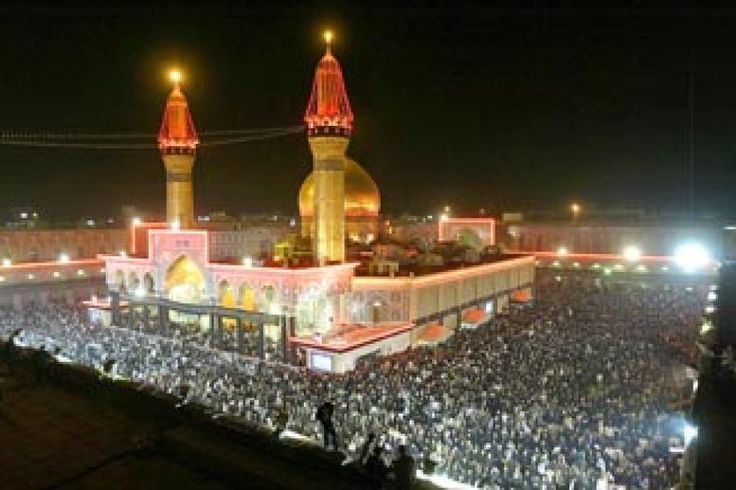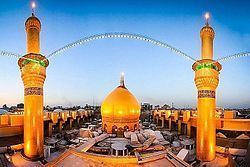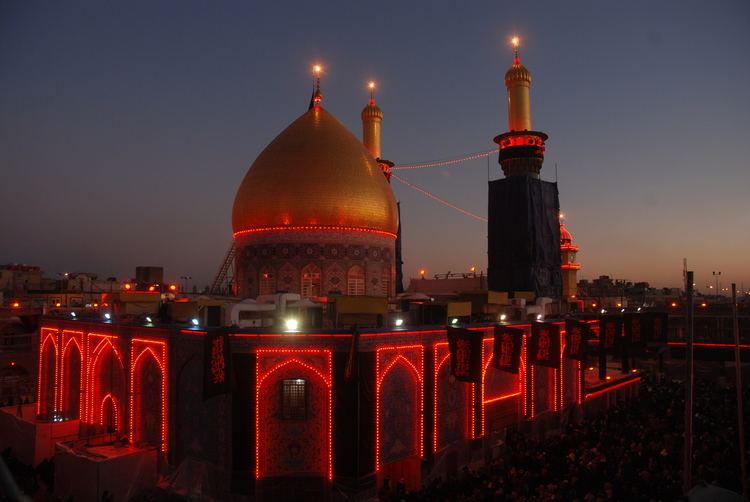Location Karbala, Iraq Architectural type Mosque | Affiliation Shia Islam | |
 | ||
Burials Husayn ibn Ali, Ali al-Akbar ibn Husayn Similar Imam Ali Mosque, Imam Reza shrine, Al Abbas Mosque, Al‑Kadhimiya Mosque, Al‑Askari Shrine | ||
The Maqam al-Imam Al-Ḥusayn ibn ‘Ali (Arabic: مَقـام الإمـام الـحـسـيـن ابـن عـلي) is the mosque and burial site of Al-Husayn ibn ‘Ali, the third Imam of Shia Islam, in the city of Karbala’, Iraq. It stands on the site of the Mausoleum of Imam Husayn, who was a grandson of Muhammad, near the place where he was martyred during the Battle of Karbala’ in 680 C.E.. The tomb of Imam Husayn is one of the holiest places for Shi‘ites, outside of Mecca and Medina, and many make pilgrimages to the site. Every year, millions of pilgrims visit the city to observe Ashura, which marks the anniversary of Imam Husayn's death.
Contents
- History of Karbala
- Karbala origin and meaning
- Buried within the Masjid
- Martyrdom and popularity
- Early development and specifications
- Timeline
- References

The Umayyad and Abbasid caliphs prevented construction of the shrines and discouraged pilgrimage to the sites. The tomb and its annexes were destroyed by Abbasid caliph Al-Mutawakkil in 850-851 and Shi'a pilgrimage was prohibited, but shrines in Karbala and Najaf were built by the Buwayhid emir 'Adud al-Daula in 979-80.

The boundary wall of the shrine surrounds wooden gates covered with glass decorations. The gates open into a courtyard separated into smaller rooms or precincts with many "Iwans" along the walls. The grave of Imam Husayn is enclosed within a metal-mesh like structure, found directly beneath the golden dome. On 5 March 2013 the process of replacing the zarih (metal mesh like structure) over the tomb of Imam Husayn Ibn Ali was completed and the new zarih inaugurated. Al Abbas Mosque is located nearby. In the coming years the shrines historic dome is set to be replaced with a modern steel framed dome, the project has been met with controversy especially by historic preservationists as it would severely distort the shrines historic integrity and character.

History of Karbala’

Karbala’, a city in Iraq, is located about 100 km southwest of Baghdad at 32.61°N, 44.08°E. It was at first a desolate place and did not witness any noteworthy activity, although it was rich in water and its soil was fertile. When Imam Husayn arrived at Karbala’ and was surrounded by the forces of Ubaidullah bin Ziyad, he inquired about the name of the place. Someone replied it is 'Aqr' - meaning 'harsh'. Imam Husain then said: we seek refuge with Allah from Al Aqr. He once again asked the name of the village. Then one of the attendants replied, its name is Karbala’. Imam Husain spontaneously declared: land of Karb and Bal’a meaning (land of) "torture and trial". In the time of Imam Husain, the place was also known as al-Ghadiriyah, Nainawa, and Shatul-Furat. Imam Husain bought a piece of land, after his arrival at Karbala from Bani Asad. He and his Ahl al Bait are buried in that portion, known by as Hair, where the Shrines are presently located. The history of destruction and reconstruction of the Shrines of Karbala’ is long. Both the Shrines were greatly extended by successive Muslim rulers, but suffered repeated destruction from attacking armies. Karbala's development was strongly influenced by the Persians.

History has recorded the names of several rulers who shared the honor of extending, decorating and keeping the Shrines and its precincts in good condition. Among them is Fateh ‘Ali Qajar, who in 1250 (A.H) ordered the construction of two Shrines, one over Imam Husain’s grave and the other over the grave of his brother, Imam Abul-Fazlil ‘Abbas ibn ‘Ali. The first dome is 27 meters high and completely covered with gold. At the bottom, it is surrounded with 12 windows, each of which is about 1.25 m away from the other, from the inside, and 1.30 m from the outside. The Shrine has an area of 59 m / 75 m with ten gates, and about 65 rooms, well decorated from the inside and outside, and used as class rooms for studying. As for the grave itself, which is in the middle of the precinct, it is called the Rawzah or garden and it has several doors. The most famous one is called "Al-Qiblah" or "Bab al Zah’ab."
Karbala’ consists of some places like Ganj E Shaheedah where all the Followers of Imam Hussain were buried and Qatl Gaah where Imam Hussain and his followers fought with the Syrian Army.
Karbala’: origin and meaning
There are many opinions among different investigators, as to the origin of the word "Karbala". Some have pointed out that "Karbala" has a connection to the "Karbalato" language, while others attempt to derive the meaning of word "Karbala" by analyzing its spelling and language. They conclude that it originates from the Arabic word "Kar Babel" which was a group of ancient Babylonian villages that included Nainawa, Al-Ghadiriyya, Karbella (Karb Illu. as in Arba Illu [Arbil]), Al-Nawaweess, and Al-Heer. This last name is today known as Al-Hair and is where Imam Imam Hussain ibn Ali’s grave is located.
The investigator Yaqut al-Hamawy had pointed out that the meaning of "Karbala" could have several explanations, one of which is that the place where Imam Hussain ibn Ali was martyred is made of soft earth - "Al-Karbalat".
According to Shia belief, the true meaning of the name Karbalā was narrated to Muhammad by the archangel Gabriel as being, "the land which will cause many agonies (karb) and afflictions (balā)."
Buried within the Masjid
The grave of Imam Husayn is found in the middle of the precinct, and is called the "Rawda" or "Garden" and it has several entry gates. The most famous one is called "Al-Qibla" or "Bāb al-Dhahab". When it is entered, one can see the tomb of Habīb ibn Madhahir al-Asadī, to the right hand side. Habīb was a friend and companion of Imam Husayn since their childhood and was honored with martyrdom at the Battle of Karbala.
Within the shrine of Imam Husayn can also be found a grave of all the 72 martyrs of Karbalā’. They were buried in a mass grave which was then covered with soil to the ground level. This mass grave is at the foot of Imam Husayn's grave. As well, beside Imam Husayn's grave are the graves of his two sons: ‘Alī al-Akbar and the 6-month old, ‘Alī al-Asghar. Also buried within the mosque is Ibrāhīm Mujab (son of the seventh Twelver Shī‘ah Imām, Imam Mūsā al-Kādhim), who spent his life preaching about Karbalā’.
Martyrdom and popularity
Karbalā was at first an uninhabited place and did not witness any constructional activity, although it was rich in water and its soil fertile.
From the time of Imam Husayn ibn ‘Alī's death in 680, pilgrimages to commemorate the massacre have often been repressed.
Despite many attempts by successive rulers, such as Al-Rashīd and Al-Mutawakkil, to put a restriction on the development of this area, it has nonetheless spread with time to become a city.
Early development and specifications
The historian Ibn Kuluwayh mentioned that those who buried Imam Husayn ibn ‘Alī, made a special and rigid construction with signs above the grave.
Higher and bigger constructions above the grave started during the ruling of al-Saffah, but heavy restrictions were put in place to prevent people from visiting the grave during the rule of Hārūn al-Rashīd.
At the time of al-Mā'mūn, construction around the grave resumed until the year 850, when al-Mutawakkil ordered the destruction and digging of the grave, and then filling the pit with water. His son who succeeded him al-Muntasir, allowed people to visit the grave site, and since then building the precinct to the grave increased and developed step by step.
On the other hand, the historian Ibn al-Athir, stated that in the year 371 AH, ‘Adhud ad-Dawlah became the first to largely lay the foundations for large scale construction, and generously decorated the place. He also built houses and markets around the precinct, and surrounded Karbalā with a high boundary wall turning it into a strong castle.
In the year 407 AH, the precinct caught fire due to the dropping of two large candles on the wooden decorations. The state minister at the time, Hasan ibn Fadl, rebuilt the damaged sections.
History has recorded the names of several ruler who shared the honor of widening, decorating or keeping the precinct in good condition. Amongst them is Fat'h ‘Alī Shāh Qājār, who in 1250 AH ordered the construction of two domes, one over Imam Husayn ibn ‘Alī's grave and the other over his brother Imam ‘Abbās ibn ‘Alī.
The first dome is 27 m high and completely covered with gold. At the bottom, it is surrounded with 12 windows, each of which is about 1.25 m away from the outside.
The mausoleum has an area of 59 m / 75 m with ten gates, and about 65 rooms, well decorated from the inside and outside, used as classrooms for studying.
Timeline
The following events are in chronological order, stating instances that widely involved the shrine, impressing its construction, renovation and series of extremist activities that reduced its structure and killed pilgrims from time to time.
